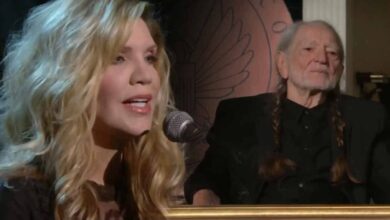Listening To Marty Haggard’s Son Singing His Father’s Song Brings Tears To Our Eyes
Merle Haggard, a hallmark figure in country music, carved out a profound and impactful career, not just with his chart-topping hits but also through deeply personal songs that resonated with the American experience. Born on April 6, 1937, in Oildale, California, Haggard grew up during the Great Depression, an era that profoundly shaped his worldview. His early life was fraught with obstacles, including the loss of his father at a young age, which left his mother to bear the brunt of parenting alone. These formative experiences fed into his songwriting, leading him to craft songs that often echoed the struggles of ordinary people.
“Mama’s Hungry Eyes,” released in 1968, represents a culmination of Haggard’s life experiences and observations of familial devotion. The song’s lyrics poetically illustrate the image of a mother who, despite her exhaustion and the weight of her burdens, finds a way to instill love and comfort in her children. The song’s title itself evokes a sense of longing and need—not just for sustenance, but for emotional support and connection. This vivid imagery taps into universal feelings of nostalgia and appreciation for the sacrifices made by caregivers, making it resonate with anyone who has felt the tender bond of family.
In his unique style, Merle Haggard painted a vivid portrait of his mother’s life, celebrating her resilience while mourning the challenging circumstances she faced. His ability to transcend personal narrative into a relatable message elevates “Mama’s Hungry Eyes” to more than just a song; it becomes a shared experience for listeners who recognize echoes of their own mothers’ struggles in Haggard’s words. His raw and authentic delivery imbues the song with a haunting quality, inviting the listener to connect deeply with the narrative.
Marty Haggard, following in his father’s footsteps, found his own voice in honoring the family legacy through music. His rendition of “Mama’s Hungry Eyes” not only preserved the essence of the original but also added depth by introducing new lyrics that expand on the maternal experience. Marty’s version, which recalls specific moments of his mother’s toil, serves to enrich the listener’s understanding of her life. By weaving personal anecdotes into the fabric of the song, he connects past and present, offering insights into shared familial experiences that many can relate to, thus broadening the song’s appeal.
The evolution of “Mama’s Hungry Eyes” from Merle’s original to Marty’s interpretation illustrates the song’s dynamic quality. It showcases how music can evolve while still staying true to its roots. As different artists reinterpret songs, they breathe new life into them, ensuring that the emotional and historical significance continues to resonate across generations. The core message about unwavering love and sacrifice remains intact, emphasizing the timelessness of the family narrative in the face of adversity.
The song’s impact extends into different avenues of music and culture, inspiring countless artists who grapple with similar themes. Its storytelling framework serves as a guide for songwriters, illustrating how personal experiences can be transformed into universal stories that touch hearts. The narrative quality of the song emphasizes the importance of honest storytelling in country music, reinforcing the genre’s long-standing tradition of reflecting the joys and struggles of everyday life.
Beyond the realm of music, “Mama’s Hungry Eyes” represents a dialogue about societal themes, such as economic hardship and familial responsibilities. Many listeners identify with the song’s portrayal of working-class struggles, allowing it to serve as a source of comfort and solidarity. In an era where such issues remain prevalent, Haggard’s work continues to find relevance, echoing the reality of modern-day hardships faced by families everywhere.
The timelessness of “Mama’s Hungry Eyes” is further exemplified by its influence on various artists within the country music genre. Over the years, it has been covered by numerous musicians, each leaving their own mark while maintaining the song’s poignant message. These adaptations not only affirm the song’s significance in the country music canon but also showcase the enduring power of storytelling in shaping cultural and musical traditions.
Ultimately, “Mama’s Hungry Eyes” is more than just a song; it is a heartfelt homage to mothers everywhere, illustrating the profound effects of their love and sacrifices. Through Merle and Marty Haggard’s interpretations, the song has woven itself into the fabric of the cultural narrative surrounding motherhood, perseverance, and familial bonds. The continued resonance of its themes in contemporary society ensures that this moving tribute will endure for future generations, reflecting the timeless loyalty and dedication found within family dynamics.
As listeners engage with both versions of “Mama’s Hungry Eyes,” they are invited not just to hear the tale of one mother’s life, but to reflect on their own stories, relationships, and the often-unrecognized sacrifices made by those who love us unconditionally. The emotional depth, combined with its rich narrative, leaves an indelible mark on the listener, ensuring that the legacy of Haggard’s reflections on motherhood will continue to be celebrated and cherished in the annals of country music history.





